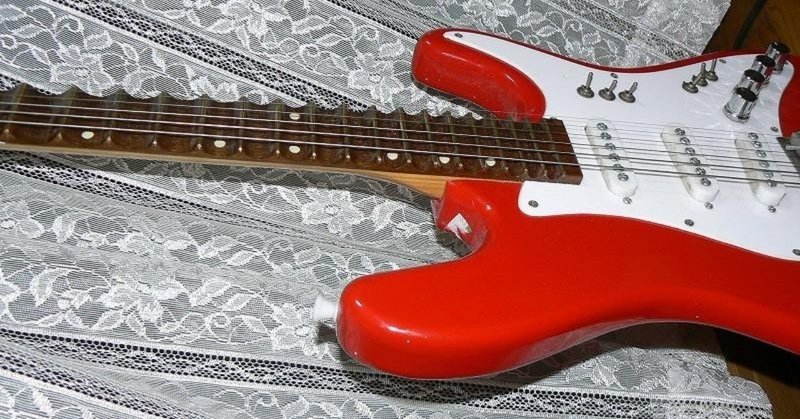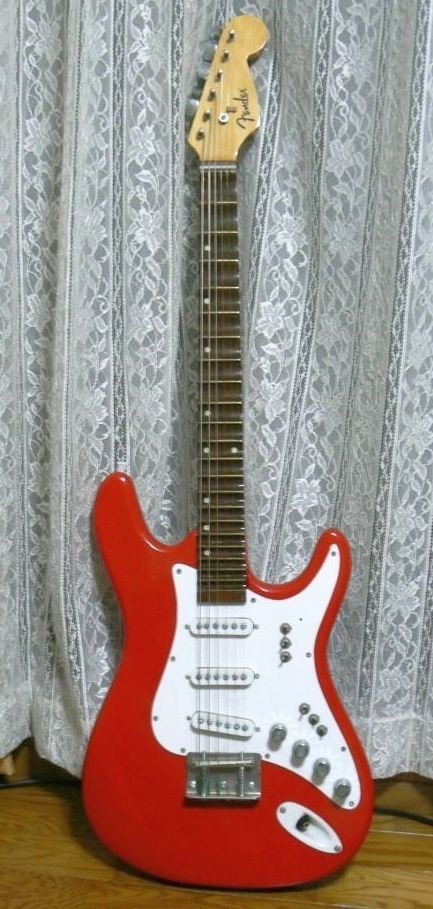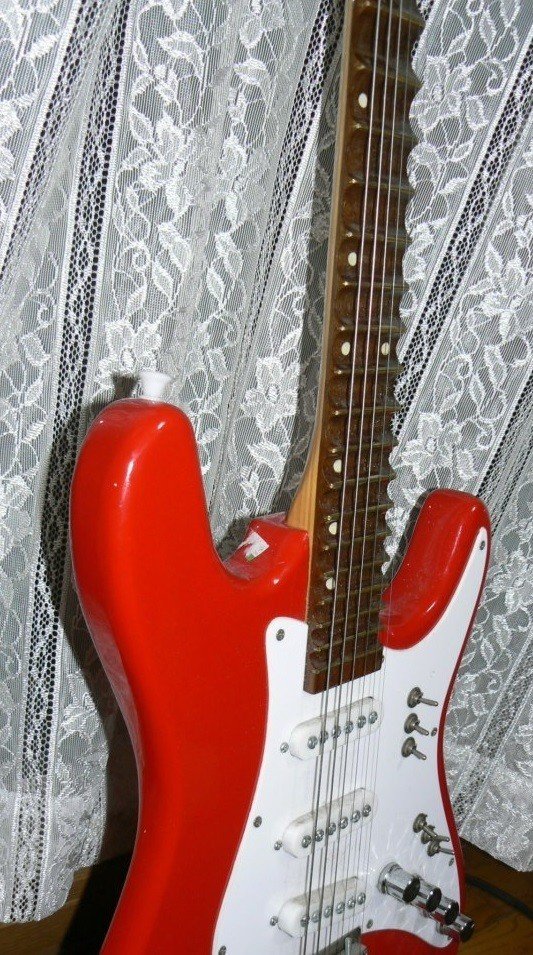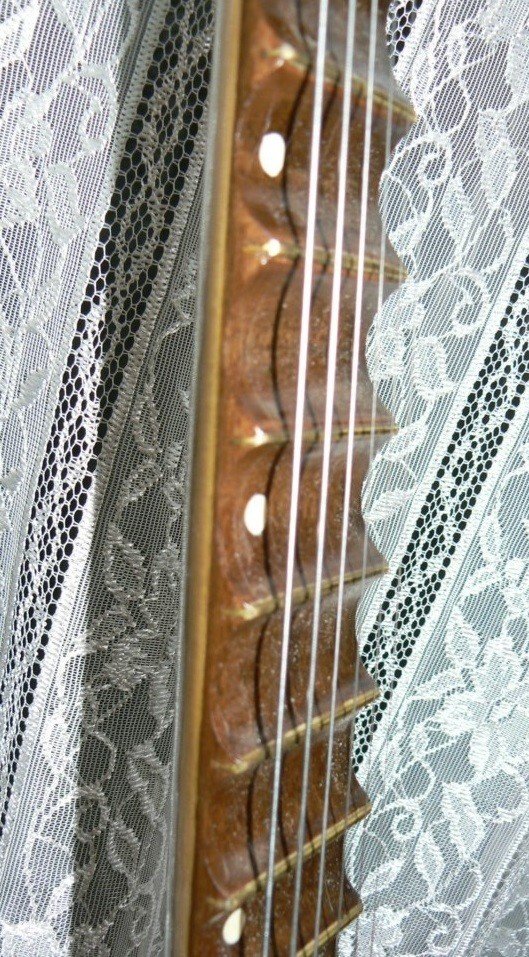
Vietnamese Guitar which has extremely scalloped fingerboard
A unique guitar localized in Vietnam
I am Yuichi Onoue, Japanese musician. In this article, I would like to describe about a unique electric guitar localized in Vietnam.
Vietnam is a treasure trove of unique stringed instruments such as Dan-bau and K'ni and so on. Among them, there is a unique guitar localized in Vietnam. This guitar is used in Vietnamese music called "Cai Luong", whether it is an acoustic type or an electric type, it looks like a normal guitar at a glance, but it features a extremely scalloped fingerboard between the frets. The photo below is this kind guitar which I own.



Many people may think of rock guitarists like Richie Blackmore and Yngiwe Malmsteen when it comes to scalloped fingerboard. And there exists some classical guitars which have a scalloped fingerboard as well. These guitar are for smooth fast playing and vibrato, but this Vietnamese guitar is scalloped far above such guitars. This makes it possible to get much more strong vibrato and pitch bends that are not possible (or difficult to do) with normal guitars. It seems that they are usually sold at musical instrument stores in urban Vietnamese cities(especially in Ho-Chin-Minh). The inventor of this guitar is said to be Kim Sinh who is guitarist of Vietnamese music Cai Luong. It gets strong pitch bend or vibrato by pushing string. And it is tuned it lower than the normal tuning of the guitar (in many cases it is lowered by 2nd to 3rd intervals). This is similar to the way that Japanese ancient instrument "Biwa(琵琶)" have a similar way to change and vibrato the pitch with pushing string like this.
Example of home country performance
Here are a few examples by Vietnamese musicians.
How about them? The shape is imitation of a fender guitar. And even there is a "Fender" logo blatantly on the head that you can see in the second video(of course, it is not Fender guitar!!). But I feel that it is really wonderful that the music which they playing is completely unique. And in the third video, it is interesting that the sharp tremolo effect is applied on near the end of the song, too.
In the next video, you can listen the sound of one octave below effect at 1:45, which is probably due to the built-in octave effect in this guitar. Because my Vietnamese guitar has an octave effect built-in. And there are some other video clips which are this octave effect is applied on.
If you are interested in Vietnamese guitar videos, search "Vong co, Guitar" on youtube.
Another unique part
Many of them are shaped like Fender Stratocaster. My one is probably the same as the red guitar in the second video I introduced before. My one also has a "Fender" logo on the head (not of course Fender). This was bought by an acquaintance who went to Vietnam in 2006. At that time, it costed around 6,000 Japanese yen(about 60 US $). It's an Asian-like cheap guitar indeed but also a multi-functional guitar. (By the way, I have never been to Vietnam as of 2019.) Please take a look at the body of my Vietnamese guitar.

There are a lot of switches and knobs. First of all, there are three toggle switches at the top. These are the on-off switches for each of the three pickups. By doing this, it is possible to output not only in-between sound of Neck and Middle PU or Middle and Bridge PU, which is general Stratocaster's in-between sound, but also in-between sound of Neck and Bridge PUs or all three PU in parallel. However, if there are switches in this position, when you play strumming chord, it may turn off unintentionally and you will have to play carefully. However, as long as I have watched a Youtube video, there is almost not chord strumming performance by Vietnamese people by using this guitar, so I think it is no problem for them. And the three switches near the knobs on the lower side are the on-off switches of octave effect for each PUs. The top three knobs are the same functions as the Stratocaster, and the bottom knob is the octave effect volume. The octave effect naturally requires a battery, but it can be used as just a passive guitar when the battery runs out. There are so many cheap parts used here, but it is a big deal that it realizes for about only about 60 US $ with all these functions.
My original tunes using Vietnamese guitar
I play this unique guitar from time to time and reflect it in my music. Because it is a self-made tune, it is not the mainstream way of playing by Vietnamese people as described above, but I am playing in a self-style while taking into account the characteristics of this instrument. I would like to introduce three such performances.
First of all, the song called “Asian Blue”. In terms of the number of views and evaluation, it is my biggest hit song.
Next is a song called "Locust Hop" with a lighter number.
This is a folky song called "Autmun Noppara".
Conclusion
I Introduced this unique Vietnamese guitar with both Vietnamese people and my playing style. I feel that this guitar has musical potential, although it is not easy to play for me. It might be good for as an instrument for your original music, like I do so. An electric guitar born in the United States was modified like this in Vietnam and unique music is played in there. Then it is brought to another country and played in a different way. I think it is interesting, isn't it? If you are traveling to Vietnam, please check it out. I also want to go to Vietnam and listen to authentic performance of this guitar.
LINKS
About scalloped fingerboard
Self-made Ribbon Controller - unique electric musical instrument
Kaisatsuko - Electric original wheel rubbed stringed instrument
Yuichi Onoue's Torigoya Sound
Yuichi Onoue on Youtube
Yuichi Onoue on Facebook
この記事が気に入ったらサポートをしてみませんか?
